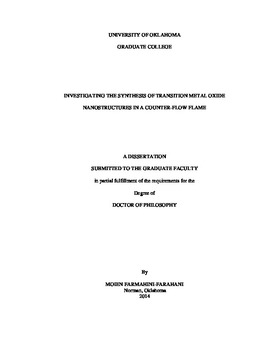| dc.description.abstract | In this dissertation, the synthesis and growth mechanisms of various transition metal oxide (TMO) nanostructures inside a counter-flow flame medium were investigated. Transition metal oxide nanostructures with distinctive properties have broad applications in microelectronic devices, gas sensors, lithium-ion batteries, and catalysts. A flame is an exothermic chemical reaction that provides required energy for inexpensive synthesis of TMO nanostructures. The counter-flow flame is characterized by high temperature and chemical species gradients, one-dimensional axial temperature variation, and an oxygen-rich zone suitable for growth of metal oxide nanomaterials. Transition metal oxide nanostructures can be grown and collected through both solid-support and gas-phase synthesis methods inside a counter-flow flame.
Herein, grown TMO nanostructures include Nb2O5, ZnO, W-doped MoO3, and WOx nanostructures. The insertion of a high purity Nb probe in the flame resulted in an instantaneous formation of a material layer coating the surface of the probe. The results show that the material layer is composed of Nb2O5 nanorods. Size and growth rate of the Nb2O5 nanorods depend on the insertion positions of the Nb probe (source) inside the flame volume. Content of oxygen in the oxidizer stream plays an important role in the growth rate of Nb2O5 nanorods; higher oxygen content leads to higher growth rates. Low electron mobility of Nb leads to the basal growth mechanism for the synthesis of Nb2O5 inside the flame. On the other hand, transition metals with high electron mobility (such as Mo, W, and Zn) mainly form through the vapor-phase growth mechanism inside the flame. The vapor-phase growth mechanism was observed during the growth of ZnO nanostructures through the solid-support synthesis. It was found that the morphology of the grown ZnO nanocrystals strongly depends on the insertion position inside the flame. Structural variations of the synthesized ZnO nanostructures include nanorods and microprisms with a large number of facets, and microprisms with a protruding nanorod. Grown nanorods are less than 100 nm in diameter and less than 1µm in length.
W-doped MoO3 nanocubes were synthesized through the gas-phase synthesis by introducing high purity Mo and W probes inside the counter-flow flame volume. Energy dispersive X-ray spectroscopy elemental mapping shows evenly distributed W, Mo, and O2 in the nanocubes. The measured lattice spacing of the nanocubes showed expanded lattice spacing which was attributed to an intercalation of tungsten atoms in the MoO3 layers. Collected samples of fully grown W-doped MoO3 nanocubes in the upper region of the flame volume show that the nanocubes have widths of less than 100 nm and well-defined edges like their base structures of MoO3.
By inserting a high purity W probe inside the flame volume, fragments of tungsten oxide material formed over the oxidizer side of the W probe. We found that this material can be converted to 1-D tungsten oxide nanorods with lower oxidation state (WOx) as exposed to the electron beam (EB) of a TEM. In this process, tungsten oxide nanorods reached ~90% of their final length within approximately one second of EB irradiation. The EB irradiation led to evaporation of a part of the fragment and subsequent growth of lower state tungsten oxide (WOx) nanorods in the vicinity of the irradiation spot. It revealed that grown WOx nanorods follow the vapor-phase growth mechanism. The evaporated material particles coalesced and deposited on the TEM grid to form seeds for further growth. These early seeds were the building blocks for the formation of fully grown structures. Further influx of tungsten particle deposition on the surface of the seeds caused growth of the seeds in the preferred direction and formation of the nanorods. The smooth surface was evidence of total diffusion of deposited particles into the surface of the early formed nanorods. The length of WOx nanorods was an exponential function of their distance to the irradiated spot. Longer nanorods were observed closer to the irradiated spot. This finding gives another unique characteristic of the flame to synthesize TMOs. | en_US |
